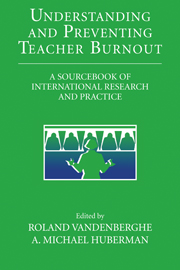Book contents
- Frontmatter
- Contents
- Contributors
- List of Figures
- List of Tables
- Foreword
- Introduction: Burnout and the Teaching Profession
- PART ONE TEACHER BURNOUT: A CRITICAL REVIEW AND SYNTHESIS
- 1 The Nomological Network of Teacher Burnout: A Literature Review and Empirically Validated Model
- 2 Stress and Burnout in the Teaching Profession: European Studies, Issues, and Research Perspectives
- 3 Teacher Stress in a Time of Reform
- 4 Teacher Burnout: A Critical Challenge for Leaders of Restructuring Schools
- 5 Intensification and Stress in Teaching
- 6 Reframing Teacher Burnout in the Context of School Reform and Teacher Development in the United States
- PART TWO TEACHER BURNOUT: PERSPECTIVES AND REMEDIES
- PART THREE TEACHER BURNOUT: A RESEARCH AND INTERVENTION AGENDA
- References
- Index
3 - Teacher Stress in a Time of Reform
Published online by Cambridge University Press: 06 January 2010
- Frontmatter
- Contents
- Contributors
- List of Figures
- List of Tables
- Foreword
- Introduction: Burnout and the Teaching Profession
- PART ONE TEACHER BURNOUT: A CRITICAL REVIEW AND SYNTHESIS
- 1 The Nomological Network of Teacher Burnout: A Literature Review and Empirically Validated Model
- 2 Stress and Burnout in the Teaching Profession: European Studies, Issues, and Research Perspectives
- 3 Teacher Stress in a Time of Reform
- 4 Teacher Burnout: A Critical Challenge for Leaders of Restructuring Schools
- 5 Intensification and Stress in Teaching
- 6 Reframing Teacher Burnout in the Context of School Reform and Teacher Development in the United States
- PART TWO TEACHER BURNOUT: PERSPECTIVES AND REMEDIES
- PART THREE TEACHER BURNOUT: A RESEARCH AND INTERVENTION AGENDA
- References
- Index
Summary
These are tough times to be a teacher. The nature and organization of the job make teaching inherently difficult. Teachers face new challenges and opportunities from increasingly diverse and needy student populations. Demands on teachers to develop new knowledge and skills and perform new tasks are increasing rapidly. So too are expectations for school and teacher performance and accountability. Taken together, the characteristics and conditions of teaching present increasingly stressful situations for teachers, situations that may have positive or deleterious consequences for them and for their work with students.
This chapter has several related purposes. The first is to explore the primary sources and consequences of stress in teachers' work. A second purpose is to analyze the ways that recent educational reforms may introduce new stress into their work. A third purpose is to assess the implications of stress in work and change for teachers. I begin my analysis with a conceptual and theoretical overview of psychological stress in the workplace, focusing particularly on organizational sources and consequences of stress. This overview draws primarily on literature from social psychology, organizational and industrial psychology, and organizational studies. I follow this discussion with a brief review of the research on work-related sources of stress for elementary and secondary teachers. Then, I turn to the issue of stress in change. After a general discussion, I analyze two current, contrasting types of reforms as sources of stress for teachers: (a) standards and assessments, and (b) teacher leadership development.
- Type
- Chapter
- Information
- Understanding and Preventing Teacher BurnoutA Sourcebook of International Research and Practice, pp. 59 - 84Publisher: Cambridge University PressPrint publication year: 1999
- 48
- Cited by

